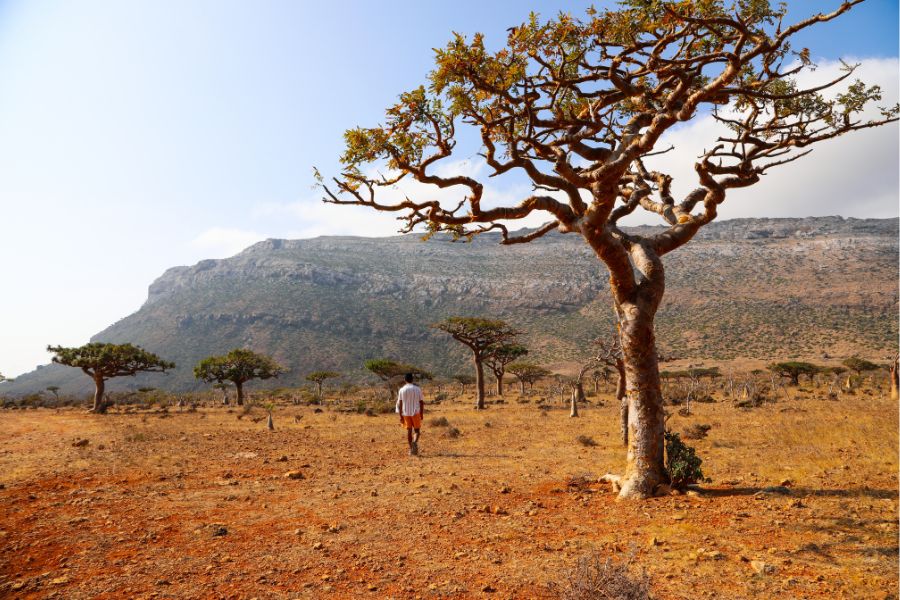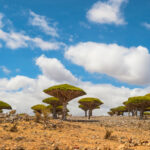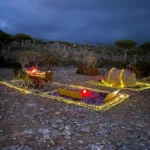
Socotra Geography and Climate
Socotra Island, often called the “Galápagos of the Indian Ocean,” is not just famous for its Dragon Blood Trees and unique wildlife — its geography and climate play a major role in shaping the island’s extraordinary landscapes. From rugged mountains to sweeping deserts and turquoise coasts, Socotra is a destination that feels otherworldly.
If you’re planning a trip, understanding Socotra’s geography and climate will help you make the most of your adventure.
-
Where is Socotra Located?
Socotra is part of Yemen but sits isolated in the northwest Indian Ocean, about 380 km (240 miles) south of mainland Arabia and 240 km (150 miles) east of the Horn of Africa.
- 🌍 Coordinates: Roughly between the Arabian Peninsula and Somalia.
- 🏝️ Archipelago: Socotra is the largest of four islands (Socotra, Abd al Kuri, Samhah, and Darsa).
- ✈️ Access: Visitors usually arrive via flights from Abu Dhabi or mainland Yemen.
👉 See more in our [How to Travel to Socotra?].
-
Socotra’s Diverse Geography
Socotra may be small (132 km long, 49 km wide), but it packs in an incredible variety of landscapes:
- 🏔️ Mountains: The Hajhir Mountains rise dramatically in the island’s center, with peaks up to 1,500 meters.
- 🌳 Plateaus: Limestone plateaus host Dragon Blood Trees and frankincense groves.
- 🏜️ Deserts & Dunes: Golden sand dunes meet turquoise seas at Arher Beach.
- 🏖️ Coastal Plains: Low-lying plains around Hadibo, Detwah Lagoon, and Qalansiyah.
- 🌊 Cliffs & Caves: Towering cliffs along the north coast hide vast caves like Hoq Cave.
👉 Read more in our [Hajhir Mountains Trekking Guide].
-
Socotra’s Climate
Socotra’s climate is unique, shaped by its monsoon winds and oceanic location. It alternates between lush greenery, dry spells, and strong winds depending on the season.
- 🌴 October – February: Cool, green, and pleasant. Perfect for hiking and camping.
- 🌞 March – May: Warmer, drier, but still great for tours and photography.
- 🌬️ June – September: Southwest monsoon season. Strong winds and rough seas make travel difficult — tours are not available.
👉 Check our [Socotra Weather Guide] for seasonal details.
-
Why Geography and Climate Matter for Travelers
Socotra’s landscapes and weather affect how you’ll explore:
- Hiking & Trekking: Best enjoyed in cooler months (Oct–Feb).
- Snorkeling & Diving: Waters are calmer from Oct–May, especially at Dihamri and Shu’ab Beach.
- Camping: Spring-fed wadis in the mountains make camping magical in the highlands.
- Photography: Golden light on dunes, cliffs, and Dragon Blood Trees varies with the season.
Conclusion: Socotra’s Natural Blueprint
Socotra’s geography and climate are what make the island so special. Rugged mountains, alien forests, vast deserts, and ever-changing winds create a destination unlike anywhere else. By planning your trip around the seasons, you’ll see Socotra at its most breathtaking.
At Socotra Phoenix Tours, we design itineraries that align with the best weather, ensuring you experience the island’s beauty comfortably and safely.
👉 Discover our [Socotra Tour Packages] and start your adventure today.








Comments (2)
Socotra Weather - Socotra Phoenix Tours,
09 September, 2025[…] See our [Socotra Geography and Climate Guide] for more […]
Everything You Need to Know About Socotra’s Hajhir Mountains - Socotra Phoenix Tours,
09 September, 2025[…] 👉 Learn more in our [Socotra Geography and Climate Guide]. […]